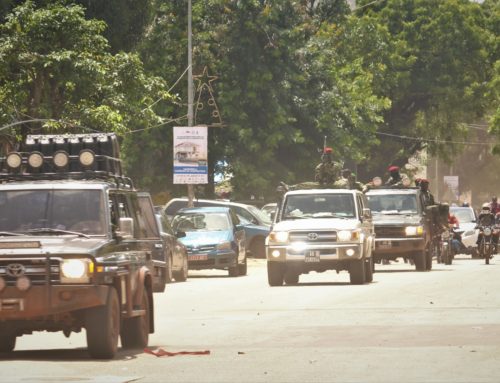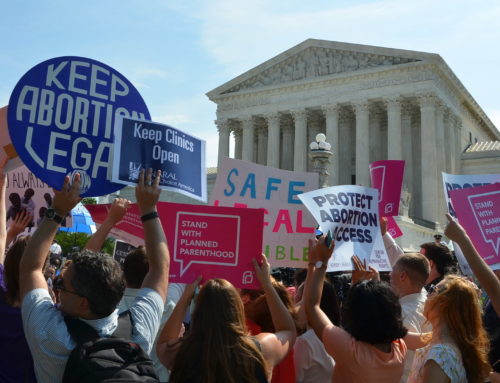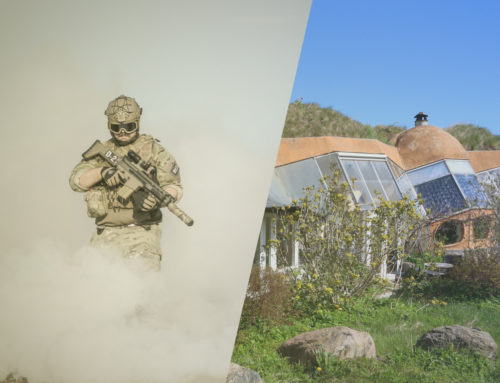By: Alex Rinn
The United States really only ever had two options for confronting Iran’s nuclear program. First, America, largely on its own, could have invaded Iran, secured its military sites, and ousted the Supreme Leader (the invasion option). Second, it could have struck essentially the kind of deal that President Obama recently appears to have secured (the diplomatic option).
The world should be extremely skeptical of the agreement with Iran. In addition to Iran’s history of flouting international nuclear obligations, for the past decades it has made a policy of working against the interests of the United States and its allies in the region. But as much as the agreement may be a hard pill to swallow, it may be the better of the two available options. If the deal is defensible at all, it is not because it better alleviates the nuclear threat from Iran. Rather, the deal with Iran, if implemented as part of a more comprehensive foreign policy, could allow the United States to direct the bulk of its energies to confronting what are actually its greatest threats, namely China and Russia, each of which seek to test America’s supremacy in the world.
Before looking more closely at the merits of the invasion and diplomatic options, it is worth considering why these really were America’s only two options. Over the years, people have suggested various alternative courses of action. Three of the most common alternative proposals are: tactical strikes on select nuclear and military facilities; an agreement in which Iran completely abandons its nuclear program; and maintenance of the status quo of sanctions and moderate nuclear activities. For the reasons explained below, none of these are more promising than the invasion and diplomatic options.
Tactical Strikes Are Not a Long-Term Solution
The tactical strike option, though appealing for its relative ease, is a poor option for several reasons. First, it is not clear that all of Iran’s key nuclear facilities could be destroyed without using nuclear weapons. Iran’s Fordow Fuel Enrichment Plant near Qom, for example, is constructed from what appears to be a repurposed tunnel complex, buried deep under a mountain. The United States has developed weapons to target such facilities—such as the Massive Ordinance Penetrator—but it is unclear how effective such weapons would be against deeply buried targets.
Second, a tactical strike is likely to prompt Iran to retaliate against America’s regional allies. Israel, even if it did not take part in the tactical strikes, would be targeted either directly or indirectly through Iranian proxies such as Hezbollah. Saudi Arabia, Egypt, Iraq, and Jordan also may be pulled in to state-on-state hostilities as Iran tries to extract a cost for such a strike. Though the tactical strike option would be intended to limit hostilities, there is a real chance that the United States would be dragged into a much broader and more engaging fight in support of its allies.
Third, and most significantly, a tactical strike is at best a temporary solution to the Iran nuclear problem. Even if the United States succeeded in destroying Iran’s key nuclear infrastructure, Iran could simply rebuild. Indeed, Defense Secretary Carter recently described the effect of such a strike as merely “a setback.” A direct military attack on Iran would only increase the perceived utility of an Iranian nuclear deterrent. Thus, the United States may be faced with the prospect of having to initiate periodic tactical strikes in a game of nuclear whack-a-mole. As the Chairman of the Joints Chiefs of Staff, General Dempsey, recently stated: “the military option isn’t use once and set aside . . . it remains in place.”
Not only is this an unsustainable policy in the long-run, it presents serious intelligence challenges. Each round of periodic strikes is predicated on the successful and timely identification of new targets. As capable as America’s intelligence community is, this would be a challenging task.
In the end, this option is likely to lead to either an invasion to conclusively end Iran’s nuclear program, or a nuclear-armed Iran the first time America fails to timely identify the proper targets. In the meantime, the Middle East probably would become an even more conflict-ridden region, as Iran reaffirms its commitment to a nuclear weapon while retaliating for the tactical strikes. The United States would have little choice but to participate in that conflict.
Iran Would Not Agree to Completely Abandon Its Nuclear Program
Some politicians and commentators say that Iran should agree to completely abandon its nuclear program before sanctions are lifted. This is fantasy. Iran would never agree to such terms. Iran is a proud country, and there is pride to be had in the technical mastery of nuclear materials. Furthermore, the Nuclear Non-Proliferation Treaty, to which Iran is a party, provides that all state parties are entitled to the peaceful uses of nuclear energy as long as they abide by their non-proliferation obligations. Though Iran has violated the Treaty before, if it were to come clean, it would not suffer the humiliation of being the only state to forsake altogether its right to the peaceful use of nuclear energy.
Any realistic nuclear agreement with Iran will allow for the continued use of nuclear technology for peaceful purposes. The best agreement would limit Iran’s nuclear activity to largely benign and easily verifiable projects. For example, the best agreement might limit Iran to the use of low-powered research reactors and the production of medical isotopes. This brings us to the “status quo” option: if the United State had held out longer, how much better of a deal could it have achieved?
Continuation of the Status Quo Would At Best Produce a Slightly Better Agreement
If the United States had waited longer before beginning negotiations with Iran, allowing the sanctions regime to further damage Iran’s economy and forestall its acquisition of conventional weapons, the United States might have secured a better deal. For example, a better deal, reached after allowing sanctions to work for a few more years, might have made possible: the complete abandonment of Iran’s uranium enrichment activities; the storage of all Iran’s enriched uranium outside of the country; a phased approached to sanctions relief; harsher restrictions on when and how Iran could resume conventional weapons and missile imports; and/or more automatic, anywhere, anytime inspections.
Of course, there is no guarantee that such additional concessions could be obtained. It is always tempting to wait for more leverage to strike a better deal, but if negotiations are to be tried, at some point one must take the plunge.
It should also be noted that when one begins negotiations is not completely in one’s own control. For example, it is unlikely that former President Ahmadinejad would have agreed to negotiate restrictions on Iran’s nuclear program no matter how badly Iran’s economy had suffered. Current President Rouhani, however, clearly presented a better opportunity for dialogue. There is no telling when another such opportunity would have come along.
Waiting also has costs. First, the nuclear issue is not the only issue of interest to the United States in the region. Persistent, simmering crises make it difficult to develop long-term strategies on other important issues like trade, human rights, and fighting Islamic extremism. Second, waiting also means that the only direction Iran would have to move on its nuclear program in the interim is forward. If sanctions were allowed to act longer, Iran’s broader economy would continue to suffer, but it almost certainly would continue to develop its nuclear program. In the meantime the breakout time for Iran to build a nuclear weapon would shrink. It also would mean that if or when negotiations were attempted, it would have more nuclear bargaining chips than it does now. On the one hand, its broader economy would be even more desperate for sanctions relief, but, on the other hand, there would be more of a nuclear program that the world would have to roll back. The net effect of these altered dynamics make it difficult to say what the result of negotiations would be. Perhaps a better deal could be struck, but it is not guaranteed.
President Obama’s critics say that he should have waited longer, that a better deal could have been struck. They may very well be right. In the end, however, a deal with Iran was always going to be struck on the central bargain of sanctions relief in exchange for 1) transparency about past nuclear activities, 2) restrictions on nuclear activities going forward, and 3) increased verification. As long as a deal credibly addressed each of these aspects, in the long run the particular details probably are less important. The real question is whether to try a deal at all, or conclude that the only solution is military invasion.
This Deal Is Better Than Invasion… For Now
An invasion of Iran would be the most effective method of removing Iran’s nascent nuclear threat. But this course of action would come with serious consequences. The most obvious argument against invasion is that it would be very costly in blood and treasure. American lives would be lost, Israeli lives would be lost, and still more Iranian lives would be lost. There probably would be global economic consequences, though these might have been short-lived.
Beyond the cost of invading Iran, America’s broader interests counsel against directing the bulk of its strategic, economic, and military energies toward Iran. The greatest threats to the United States over the next century do not lie in the Middle East. China, and to a lesser extent, Russia and the future of Europe deserve the bulk of America’s foreign policy focus. An invasion of Iran would divert resources and distract America from its most significant interests for a decade.
While America managed an invasion and its consequences for a decade, China would continue to progress toward its goal of displacing the United States as the global superpower. China would continue to develop its conventional military assets, its space capabilities, and most worryingly, its cyber capabilities. In 2013, the Director of National Intelligence, James Clapper, said that cyberattacks pose the greatest threat to national security. Indeed, as The Economist recently reported, China has been increasingly active in its attempts to infiltrate and exploit sensitive national security information. Most recently, China appears to have breached the Office of Personnel Management, which stores security clearance information on millions of past and current federal employees. According to The Wall Street Journal, China also has stolen data from the Pentagon, Los Alamos, oil pipelines, and power plants, and after stealing data from Lockheed Martin on the F-35, China debuted its own stealth fighter. Back in the physical world, China may become even more assertive in the South China Sea, limiting America’s naval and intelligence capabilities in the hemisphere. The United States would of course try to maintain its strategic advantages, but it would be unable to devote the level of resources and attention that the threat from China demands.
Russia is likely to benefit from an Iranian distraction as well. Perhaps it would annex Ukraine. Most worryingly, it may attempt to break NATO by threatening Poland or the Czech Republic at a time when the United States and NATO cannot sufficiently respond. These are America’s greatest threats, and the agreement with Iran could make it possible for America to direct its attention where it is most needed.
I said above that any agreement with Iran must produce 1) transparency about past nuclear activities, 2) restrictions on nuclear activities going forward, and 3) increased verification. The deal largely satisfies these criteria, albeit not as well as it could have. While the world can expect better transparency into Iran’s past activities and significant restrictions on its nuclear activities for at least the next decade, the verification provisions of the agreement are more worrisome.
First, although Iran surely will try to hide critical information regarding its past nuclear activities, we are likely to learn a good deal more about the so-called “possible military dimensions” of its nuclear program. The United States should stand firm and refuse any sanctions relief until Iran resolves questions about its past activities.
Second, though the restrictions on Iran’s nuclear capabilities will expire in ten to fifteen years, for that time period its capabilities will be significantly curtailed. The Economist recently reported that even Israel’s generals and intelligence service believe that Iran essentially has accepted a ten year hiatus on its nuclear program. And, as stated recently by the former Director of Israel’s Mossad, Efraim Halevy (who was appointed by Benjamin Netanyahu), what will happen in ten to fifteen years is a moot point—in international relations, a decade is like eternity.
The weakest point of the three criteria is verification. Significantly, Iran has agreed to adopt the IAEA’s Additional Protocol, and Modified Code 3.1 (requiring early disclosure of design information for nuclear facilities) as well as additional inspection measures allowing the IAEA access to nuclear sites and other sites with suspected undeclared activities. But critics of the deal rightly point out that these are not the “anytime, anywhere” kind of inspections that many wanted, and that Iran has shown are warranted. Iran could delay critical inspections with bureaucratic obstacles sanctioned by the agreement itself—the famous 24 day access timetable.
Nonetheless, Iran will be watched more closely than ever before. Though Iran implemented the Additional Protocol on a voluntary basis from 2003 to 2006, Iran’s implementation of the Additional Protocol under the new agreement is nondiscretionary. Also, though subject to a 24 day timescale, the agreement provides inspectors with greater rights to demand inspections when necessary. And, unlike prior safeguard agreements, which Iran tended to violate with few consequences, the current agreement allows for sanctions to be “snapped-back” into place if Iran does not comply with its international obligations. Given Iran’s history of noncompliance, this is a significant enforcement mechanism. No verification regime can be one hundred percent effective, but this agreement increases the cost of cheating for Iran, and increases the chances that the world will discover if Iran cheats.
In short, the costs of invasion are high, and while the agreement is far from perfect, it does offer real benefits—but America must act on them. Iran should know that this is its last, best chance to rejoin the league of respectable nations. If Iran cheats again, if it is found to have been working in secret toward a nuclear weapon, the response should not be more negotiations. In that unfortunate scenario, the world, led by the United States, must enforce its rights militarily. In the meantime, the agreement provides America the capacity to deal with the most significant strategic threats emanating from China and Russia. The greatest shame will be if America fails to capitalize on this opportunity.
Alex Rinn is an attorney and former CIA analyst.









Alex, this is a very well written article, and I can tell that it has taken you some time to do. I commend you on a job well done. I do, however, have some concerns with what you have posted.
1. With respect to there only being two viable options
I believe that there are more than 2 options that were available. When Benjamin Netanyahu addressed Congress earlier this year, he spoke of a “better deal” – a deal that would see other aspects of Iran’s network of worldwide terror being suppressed; a deal that would account for Iran’s warmongering tone toward Israel and the West; a deal that would seriously hinder Iran’s ability to make a bomb. None of these points were ever addressed in the deal. Why is it that Kerry and the Obama administration appear to be negotiating from a position of weakness? Iran’s economy was, prior to this deal, in a very weak position. There was a large chance that the Iranian people would have taken some steps to overthrow their government had the years of sanctions only been upheld, rather than what appears to be a total capitulation by the West.
Another additional option would have been to maintain the status quo or increase sanctions on Iran. While those things seem to not have worked, they were taking a toll and could have resulted in an internal struggle for the Islamic regime, and thus, an overthrow by a group that could have been more friendly to the West. While there are some concerns with this, such as a power vacuum being filled by terrorists, one has to beg the question – would that be worse than the current regime?
2. Why a better deal, through either protracted negotiation or increased sanctions, would have been better
A better deal, though not immediate, would have been to everyone’s advantage. The West is now faced with a surely nuclear Iran. It might not be today, next month or next year. But by making this deal, the current administration has passed the buck to another generation to deal with. In 10 years, we will be faced with a stronger Iran, buoyed by acceptance by the West and flooded with cash to buy weapons. We know that Israel is threatened. Israel will arm and will prepare to defend itself – either by committing a preemptive strike (which we know they have done in the past – the 6 Day War or Osirak), or by waiting and perfecting their second strike ability (i.e., nuclear submarines). But what about the Sunni powers in the region that obviously feel threatened by a stronger and nuclear Iran – Saudi Arabia and Egypt, as well as the Gulf States. The Gulf States are awash with cash. The Saudis are too. I doubt that they will sit idly by. I fully expect that this deal will lead to a nuclear arms race in the Middle East. That is not a neighborhood where we need a nuclear arm’s race – especially with ISIS and other fanatical groups often popping out of nowhere and capturing swaths of territory and weaponry.
3. You state the agreement allows Iran to become part of the respectable group of nations if it does not cheat
Unfortunately, the deal allows Iran to get away with so much (continued enrichment and development; limited inspections; some weird side deal with IAEA) that it does not need to cheat to continue on its course to development of a nuclear arsenal, at the same time as rearming and purchasing new weapons and defense systems from the Chinese and Russians. Iran will be seen as “respectable” without having to do anything to contravene the agreement. Then, once the agreement is over, they will be able to turn on the “Great Satan” with all of their new found might and power.
Steve,
Thank you for your thoughtful comments. In my article I tried to make “the best case for the Iran nuclear deal,” as indicated by the title. There are indeed good arguments to be made against the deal, such as the risk we will not detect cheating and the dangers associated with allowing Iran to access so much cash in the meantime. Perhaps the greatest risk (at least to the United States) emanating from the Middle East is the potential for a nuclear arms race in the region. You allude to this possibility in your second set of comments, but it is not clear to me that the Iran deal actually increases this risk. I think a good argument can be made that the deal decreases the risk.
As an initial matter, I think it is highly improbable at this time that the Sunni powers would attempt to actually produce a nuclear weapon. Doing so would be extremely dangerous and damaging for any of those countries. They should realize that the United States would turn from friend to foe. A more realistic scenario is that these countries begin to develop a nuclear knowledge base, and attempt to maintain parity with Iran in nuclear technology—hedging for the potential of a dark future. But in this scenario, the deal actually decreases the level of technology development required to maintain parity. Doing nothing, in hopes of more leverage for a better deal or a regime change, would allow Iran to augment its nuclear capabilities and, I think, increase the risk of regional nuclear proliferation.
I have a few other brief thoughts on your comments. First, I think Mr. Netanyahu’s “better deal” that you describe is fantasy. Linking a nuclear agreement to Iran’s support of Hezbollah and connections to terror, and its tone toward Israel would only ensure that a deal would not be reached. These are fundamental aspects of Iran’s regime that will not easily change. I do not think it is prudent to wait for the conditions in which such change is possible before addressing the nuclear threat posed by Iran.
Second, I see little evidence that fundamental regime change is coming in Iran that would lead to a chance for the “better deal” addressed above. I think you paint an extraordinarily optimistic view by describing the potential for such change as “a large chance.”
Finally, you say that when the agreement is over, Iran “will be able to turn on the ‘Great Satan’ with all of their new found might and power.” If the world, led by the United States, must again confront Iran over its nuclear program after the agreement ends, Iran surely will be more capable than it is today. But even with its “new found power and might,” its capabilities will still pale in comparison to those of the United States. In other words, I am not concerned that any realistic potential increase in Iran’s conventional capabilities over the next decade will prove a significant deterrent to the United States taking military action if the need arises.
My comment on Rinn is that he prefers appeasement rather than taking out the cancer. The nuclear threat is real and if we wait long enough for the white cloud it will come from North Korea before the mullahs arthritic fingers press the button.